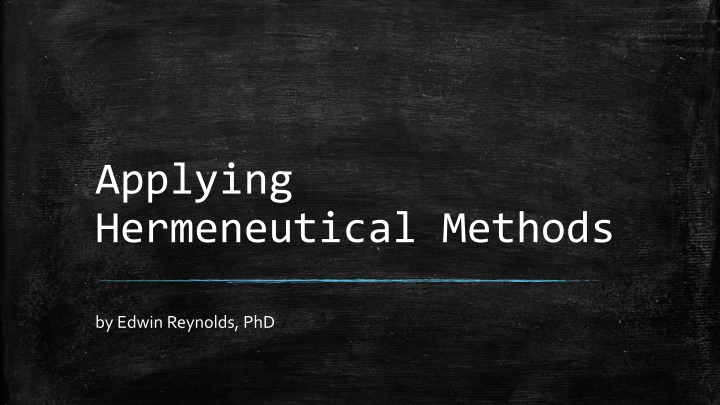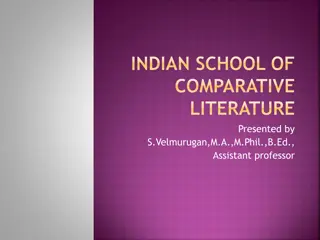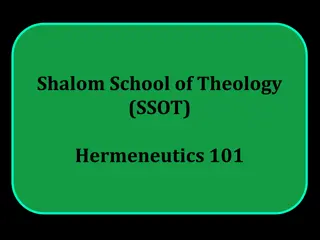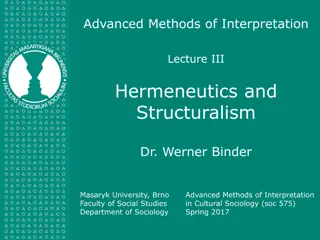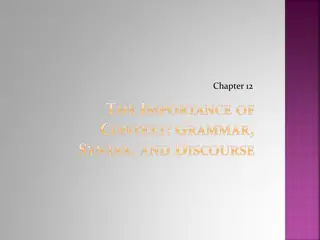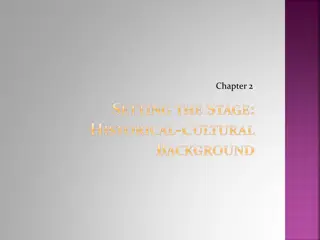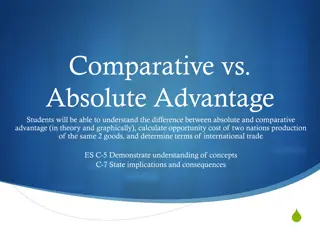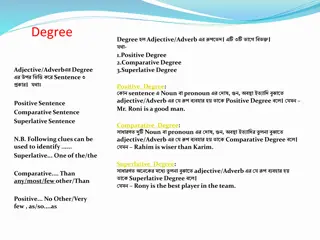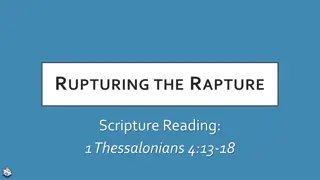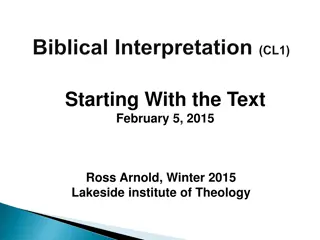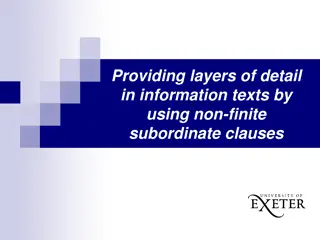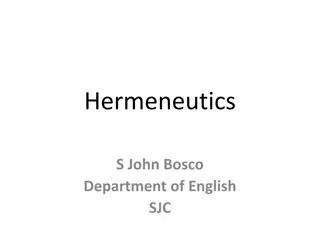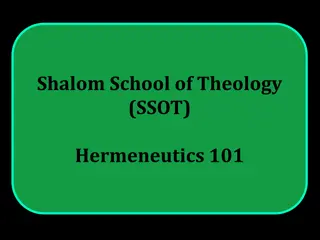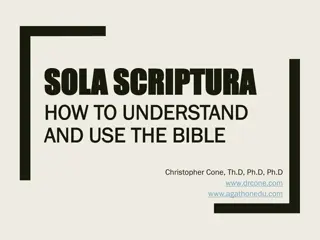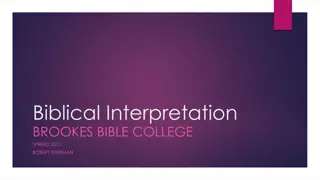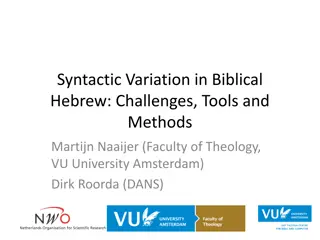Comparative Hermeneutics: Understanding Biblical Texts
Explore the application of hermeneutical methods on biblical texts such as Psalm 23 and 1 Tim. 2 through interpretation, translation, and contextual analysis. Delve into the meaning of texts, the role of signs and symbols, and the impact of varying presuppositions on interpretation. Reflect on the postmodern view of scripture and its ontology. Contemplate the essence of the Bible and its multifaceted extensions in history, culture, and faith.
Download Presentation

Please find below an Image/Link to download the presentation.
The content on the website is provided AS IS for your information and personal use only. It may not be sold, licensed, or shared on other websites without obtaining consent from the author.If you encounter any issues during the download, it is possible that the publisher has removed the file from their server.
You are allowed to download the files provided on this website for personal or commercial use, subject to the condition that they are used lawfully. All files are the property of their respective owners.
The content on the website is provided AS IS for your information and personal use only. It may not be sold, licensed, or shared on other websites without obtaining consent from the author.
E N D
Presentation Transcript
Applying Hermeneutical Methods by Edwin Reynolds, PhD
Comparative Hermeneutics The goal of this presentation is to compare the results of practicing various hermeneutical methods through application to specific biblical texts. This will be done by using two different kinds of texts, one from the OT poetic literature, Psalm 23, and one from the NT epistles, 1 Tim 2. I would like to thank my friend Dr. Felix Cortez of the SDA Theological Seminary for allowing me to adapt some of his material on Psalm 23.
What Is A Text? A text is a group of entities, used as signs, which are selected, arranged, and intendedby an author in a certain contextto convey some specific meaning. Jorge J. E. Gracia, A Theory of Textuality: The Logic and Epistemology (Albany, NY: SUNY Press, 1995), 4.
Interpreting the Text A signis a symbol that conveys meaning indirectly. One needs to interpret the sign to obtain meaning. Selection of the signs (words) can change meaning. Rearrangementof order can change meaning. Interpretation of intentioncan change meaning. Interpretation of literary and/or historical context can change meaning.
Fundamentals of Interpretation Every translation is an interpretation. Presuppositions and preunderstandings affect interpretation. They need to be recognized and set aside, as far as possible. Grammar, vocabulary, and syntax of the original text is important for careful exegesis of a text. Context is very important to meaning, including historical and canonical context, but the immediate literary context is the final determiner of meaning.
A Postmodern Presupposition There is no ontology of scripture. The concept has no metaphysical, nor logical, referent; there is nothing that scripture finally is. . . . [A]t issue is not the texts of scripture that are to be understood and about which a theory is to be sought, but the dynamic of human involvement with them. . . . Scripture has been . . . a human activity: it has been also a human propensity, a potentiality. William Cantrell Smith, What Is Scripture? A Comparative Approach (Minneapolis: Augsburg Books, 2000).
What Is the Bible? Does it have no ontology at all? Is it an extension of the history and culture of the times? Is it an extension of a human author or authors? Is it an extension of any reader? Is it an extension of the believer? Is it an extension of the church? Is it an extension of the Divine Author?
Medieval Interpretation The allegorical method was widely practiced in the Medieval period. It interpreted the details of the text as representing abstract entities, ideas, virtues, vices, or philosophical teachings. Neoplatonic dualism taught that spiritual realities were more important than the things that symbolized those realities. The Bible was considered to be an extension of the Church. The Church taught what Scripture meant, and the reader was expected to find (impose) that meaning in the text (eisegesis).
Example of Medieval Allegorization [But] that one desired by all the nations, nonetheless, loved the Church, who was bathing on the rooftop, that is, cleansing herself from the filth of the world and rising above and trampling upon its house of clay by spiritual contemplation. And, after having come to know her through his first encounter with her, he afterward completely removed the devil from her, killed him, and united her to himself in perpetual marriage. Let us hate the sin but not destroy the prophecy. Augustine Faust. 22.87 (on David and Bathsheba in 2 Sam 12)
Psalm 23 in Medieval Interpretation Still waters (v. 2) = baptism The rod and the staff (v. 4) = the cross, which is formed of two parts: The upright (staff) comforts and directs the believer The crossbar (rod) is used against demons The table (v. 5) = the altar of the Eucharist. (The view of Augustine, Cassidorus, and others)
Reformation Interpretation When I was a monk, I was an expert at allegorizing Scripture, but now my best skill is only to give the literal, simple sense of Scripture, from which comes power, life, comfort, and instruction. Martin Luther, quoted in Gerhard F. Hasel, Biblical Interpretation Today (Silver Spring, MD: Biblical Research Institute, 1985), 3. The Bible is an extension of the Divine Author.
Enlightenment Principles Rationalism, humanism, and deism trumped Divine revelation. Man is the measure of all things. The Bible was a purely human product, to be read and interpreted just like any other book. God is totally transcendant, uninvolved with time and history. Supernatural claims are mythological. History is a closed continuum of cause and effect. The present is the key to understanding the past.
Enlightenment Interpretation One must read the Bible in human terms, since it is a book written by humans and for humans. Human is the language, human the means by which it was written down and preserved; human finally is the sense in which it is to be understood, every aid that illuminates it, as well as the purpose and use to which it is to be applied. J. G. Herder, quoted in James L. Kugel, How to Read the Bible: A Guide to Scripture, Then and Now (New York: Free Press, 2007), 665.
Modern Scientific Interpretation Interpretation in the Modern period was the product of the Englightenment. It used the methods of the Enlightenment, which claimed to be scientific and objective, yielding an assured result. Its presuppositions are in direct conflict with the claims of Scripture, denying anything supernatural, including the activity of God in history. The Bible was an extension of the human authors and their own history and culture.
Psalm 23 in Modern Interpretation Psalm 23 was not written by David but by an unknown believer who was celebrating his acquittal at the court. Thus, Taylor and McCullough explain: It is clear from the reference to the house of the Lord (vs. 6) that the psalm is not Davidic. The individualism of the psalm points to a date in the postexilic period when the relations of the Lord to the individual claimed special attention. The class to which this psalm belongs appears to be a late development in the history of Hebrew psalmody.
Psalm 23 and Source Criticism David was not the author of Psalm 23. It is not earlier than Solomon or later than Rehoboam. David s name in the superscription indicates only a collection made in his name in the late Persian period. It is comprised of 3 strophes with parallel figures: (1) the shepherd, (2) the guide, and (3) the host. There is no overlap in these separate themes. C. A. Briggs and E. G. Briggs, A Critical and Exegetical Commentary on the Book of Psalms (Edinburgh: T. & T. Clark, 1906), 1:207-8.
Postmodern Interpretation Postmodernism is a skeptical response to modernism s assurance that certainty ( truth ) can be achieved through objective, scientific study. It is a hermeneutic of suspicion. It begins from the premise that there is nothing that can be known for certain, no absolute truth, but that everything is relative to one s individual experience. The Bible does not communicate truth for everyone. It can only provide an existential encounter in which the reader relates the text to his/her own experience. Truth for the author is not necessarily truth for the reader.
Postmodern Deconstructionism Power controls through deception and cannot be trusted. There is no truth spoken by authority. Everyone can trust only their own experience and judgment and find what is true for themselves. No one should judge another person s assessment of truth. Each person is responsible only for their own idea of truth, and it is relative to their own experience. There is no objective meaning to the text. One text is in conflict with another text. Deconstruction allows the reader to determine what text he/she finds meaningful.
Psalm 23 in Deconstructionism Psalm 23 is a poem about life vs. death. The Shepherd is supposed to represent life, but is the Shepherd really about life? Why does he take the sheep through the valley of the shadow of death? The sheep finally arrive at the House of Yahweh, which they can only achieve, apparently, by passing through the valley of the shadow of death. Death and life are both equally relevant for people.
Gender Criticism The Bible was written by people in a patriarchal culture and needs to be interpreted in such a way as to eliminate the gender bias in the text. Any text that suggests that men hold authority or should have leadership, whether in the home, in society, in the church, or in civil positions, must be reinterpreted in harmony with the principles of full egalitarianism, which represents true justice. The Bible is just an extension of its own culture.
Psalm 23 and Gender Criticism The Shepherd represents the male. The sheep represent the female. The psalmist is trying to uphold the idea of male dominance. The sheep need the Shepherd to make it safely though challenges to the House of Yahweh. This psalm must be reinterpreted in today s society to eliminate the gender bias found in the text.
Psalm 23 and Post-colonial Criticism The shepherd is portrayed as guiding and caring for the sheep, but the shepherd is the colonial power. The colonial power has no interest in caring for the sheep but only in manipulating the sheep for its own interests. Why does the shepherd lead the sheep into the dark valley of death? Should the sheep trust the shepherd? The text must be interpreted in view of post-colonial liberation movements, breaking free from the oppressive oversight of the shepherd.
Historical-Grammatical Interpretation In contrast to these unbiblical alternative methods of reading and interpreting the text, the historical- grammatical method begins with biblical principles and methods and ends with biblical conclusions. We will quickly consider how to understand a very controversial passage from 1 Tim 2:11-14 from a historical-grammatical (H-G) method in contrast with other methods.
Exegetical Steps for 1 Tim 2:11-14 1. Define the unit: 1 Tim 2:11-14 is part of a larger unit which forms its context the entire chapter is its context, and some scholars include chapter 3. Paul instructs men and women how they should conduct themselves in a church setting (3:15). 2. Establish the text: Checking the text for variants, we find that there are no significant variants that would require special study to determine the reading of the text and its interpretation.
Exegetical Steps for 1 Tim 2:11-14 (2) 3. Translate the text: In translating the Greek text into English, we note any particular issues of translation, such as the infinitive authentein in v. 11. It appears only here in the NT and its use is debated. Most scholars, including Bauer s lexicon, insist that it means to domineer, to exercise authority over. 4. Analyze the form and structure: The unit s genre is epistle, including both theological instruction and practical admonition. The unit moves from how to pray to how to behave in a worship setting. It begins with addressing men, then women, in each subsection.
Exegetical Steps for 1 Tim 2:11-14 (3) 5. Analyze the grammatical and lexical data: There are a number of important words in this passage which require study. Most suggest propriety in dress and decorum: holy, modesty, sober-minded, appropriate, godliness, good works, quietness, submissiveness, and not to domineer over. The prohibition ( I do not permit ) is explained (gar), not by a local social or cultural situation but by a biblical and theological one, which universalizes the injunction.
Exegetical Steps for 1 Tim 2:11-14 (4) 6. Answer Questions of Introduction (Who? When? Where? What? Why?): Written by Paul to Timothy, his mentee, who was serving as church pastor/elder at Ephesus, about A.D. 64-65. He wrote to counsel him on his pastoral leadership and how to deal with problems in the church. This section was written so that you will know how people ought to conduct themselves in God s household, which is the church of the living God (3:15). It is not about home life.
Exegetical Steps for 1 Tim 2:11-14 (5) 7. Research the historical context: This step requires discretion, to discern what is relevant to the context of the passage under consideration. If the passage points to issues in the local context, these need to be carefully studied for relevance. If not, dragging in things that are not relevant only confuses the issue. There is nothing in the context of this passage that suggests that Paul was discussing local cultural or social issues. However, some interpreters read in purported backgrounds that are not alluded to in the text while ignoring the biblical explanations.
Richard Clark Kroeger and Catherine Clark Kroeger In their book I Suffer Not a Woman : Rethinking 1 Timothy 2:11-15 (Grand Rapids: Baker, 1992), the Kroegersargue that the historical context of the passage was a form of Gnosticism existing in Ephesus in the first century that worshipped Eve as the mediator who brought true knowledge to the human race and the serpent as the one beneficent in helping Adam and Eve shake off the deception perpetrated on them by the Creator (p. 60). Christian women in Ephesus had been taken in by this cult, and Paul was warning Timothy against letting them teach in the Ephesus church.
Exegetical Steps for 1 Tim 2:11-14 (7) 8. Study the literary context: Observe the connections with the larger context, its themes and theology. In this passage, the larger context is the church and worship, not the home. It is not about husbands and wives, as some want to insist. The immediate text is introduced in v. 8 with how the men (tous andras) should approach God in prayer. Then Paul turns to how women likewise should model humility before God in their dress and demeanor, showing that good character is more important than outward show.
Exegetical Steps for 1 Tim 2:11-14 (8) 8. (cont.) Paul continues in chap. 3 with the qualities of church leaders, specifically of overseers (episkopoi) and deacons, including their wives and children. This reveals again that the context is instruction for the church setting. This is clarified in 3:5,15. Verse 4 may sound like instruction for the home ( He must manage his own household competently and have his children under control with all dignity ), but v. 5 makes clear that the real issue is the church: (If anyone does not know how to manage his own household, how will he take care of God s church?) (CSB). Verse 15 clinches it.
Exegetical Steps for 1 Tim 2:11-14 (9) 9. Study the canonical context: The canonical context is explicit here, for Paul cites Gen 2-3 as theological rationale in vv. 13-14: For Adam was formed first, then Eve. And Adam was not deceived, but the woman was deceived and transgressed (CSB). There is a clear parallel in 1 Cor 11:7-9, where Paul again cites Gen 2 (pre-Fall) as his rationale for the distinctions in gender roles which he is addressing in that passage. He cites the order and purpose of creation of the man and the woman as distinctive, without regard to the Fall.
Exegetical Steps for 1 Tim 2:11-14 (10) 9. (cont.) Also, in 1 Cor 11, Paul makes 6 arguments for a universal practice of these gender distinctions: 1. Man is the glory of God, but woman is the glory of man (v. 7). 2. Man did not come from woman, but woman from man (v. 8). 3. Man was not created for woman, but woman for man (v. 9). 4. A woman should have a symbol of authority on her head because of the angels (v. 10). (Cf. Isa 6:2). 5. What is created natural is short hair for men and long hair for women, for God gave woman hair for a covering (vv. 14-15). 6. The churches of God have no practice other than this (v. 16).
Exegetical Steps for 1 Tim 2:11-14 (11) 9. (cont.) Again, in 1 Cor 14, Paul addresses the role of women in the church, including silence, and he presents several arguments for universal practice: 1. As in all the churches of the saints, the women should be silent in the churches (vv. 33-34 CSB). 2. For they are not permitted to speak, but are to submit themselves, as the law also says (v. 34b CSB). 3. If anyone thinks he is a prophet or spiritual, he should recognize that what I write to you is the Lord s command. If anyone ignores this, he will be ignored (vv. 37-38).
Exegetical Steps for 1 Tim 2:11-14 (12) Other clear canonical parallels in the unit include 1 Pet 2:1-6, which discusses dress and decorum for women in similar terms to those in 1 Tim 2, though not in a church setting. This shows the universal nature of the principles and the instruction. Also, the parallels with instruction in Eph5:22-33 and Col 3:18 seem to support universal counsel. The parallels between 1 Tim 3 and Titus 1 suggest that that instruction was not only for Ephesus.
Exegetical Steps for 1 Tim 2:11-14 (13) 10. Read the secondary literature: This is not because the secondary literature has the final word, but after doing your study in the text, it is helpful to check what others have found. This can either confirm or challenge your results. If it challenges your results, you need to justify your results from Scripture and challenge their results. If you have done careful work, most scholars will support your conclusions, at least those who are operating from biblical presuppositions and methods.
Sharon Hodgin Gritz In her book Paul, Women Teachers, and the Mother Goddess at Ephesus: A Study of 1 Tim 2:9-15 in Light of the Religious and Cultural Milieu of the First Century(Lanham, MD: University Press of America, 1991), Gritz argues that the context of the passage was a matriarchal society in which the Mother Goddess Cybele/Artemis subordinated her male consort (p. 34), and this influence led some women in the church of Ephesus to behave accordingly. So Paul was addressing a merely local phenomenon.
Marina Warner In The First Epistle of Paul the Apostle to Timothy, in Incarnation: Contemporary Writers on the New Testament, ed. Alfred Corn (New York: Penguin, 1990), Warner writes that Paul was arrogant, overbearing, even violent in his hatred of women speaking. Since Eve, the type of all women to come, sinned through speech, by tempting Adam to eat, speech must be denied her daughters (p. 232). Women can be saved only by silently submitting to a childbearing role while men rule in the family and in the church (p. 235).
Marina Warner (cont.) Citing Elaine Pagels, Adam, Eve, and the Serpent, pp. 22-31, Warner concludes, Biblical scholars now argue that the mitigation of the apostle s usual stringent asceticism in the First and Second Epistles to Timothy and the Epistle to Titus points to a follower and imitator of Saint Paul who sought to domesticate Pauline doctrine and adapt it to a traditional Jewish idea of the worth of marriage, the importance of hierarchy within the family, and tribal obligations to widows (p. 235).
William Barclay In The Letters to Timothy, Titus, and Philemon, in his NewDaily Study Bible, 3d ed. (Louisville, KY: Westminster John Knox Press, 2003), Barclay states that Paul was writing against both a Jewish and Greek background in which women were regarded as little more than slaves. Women who spoke out in public were considered loose women (pp. 74-75). The early church did not lay down these regulations as in any sense permanent, but as being necessary in the situation in which it found itself (p. 76).
Church of the Nazarene Textbook In a textbook entitled Discovering the New Testament: Community and Faith, edited by Alex Varughese (Kansas City: Beacon Hill Press, 2005), we are told that Paul is here at odds with himself and with the rest of Scripture. If we take these texts at face value, . . . we might be tempted to agree with those who deny women any place of ministry in the Christian church (p. 286). However, Gal 3:28 should be our primary hermeneutical guideline with which we understand his perspective on women in ministry (ibid.).
More typical interpretations The above interpretations are not representative of most commentaries, but do represent some of the recent attempts to explain away what seems to be self-evident in a natural reading of the text in its literary context. A number of commentaries argue that Paul is talking about husbands and wives, not a church setting. Most commentaries, however, across a fairly broad spectrum, provide a fairly traditional interpretation.
William Hendriksen In his Exposition of the Pastoral Epistles, New Testament Commentary (Grand Rapids: Baker, 1965), Hendriksen argues that these directives regarding the woman s role in connection with public worship are based not on temporary or contemporary conditions or circumstances but on two facts that have meaning for all time, namely, the fact of creationand the fact of the entrance of sin (p. 109).
S. M. Baugh In 1 & 2 Timothy, Titus, Zondervan Illustrated Bible Backgrounds Commentary, softcover ed. (Grand Rapids: Zondervan, 2002), Baugh insists, Paul s injunctions in 1 Timothy 1:11-12 require no special historical insights to understand (p. 55). He argues that There are abundant indicators in the historical remains of ancient Ephesus that it cannot be characterized as a feminist culture (ibid.). He goes on to illustrate his point with facts from ancient Ephesus.
S. M. Baugh (cont.) Baugh concludes, It has been asserted that Ephesus was such a haven for ancient feminism that Paul is only speaking about Ephesian women being in submission to male church officers here. However, this is not what he says prima facie. Paul s statements in these verses were meant to be taken as parallel with those addressed to men everywhere (2:8). . . . Paul roots his instructions on male-female relations in the church in 2:9-12 squarely in the creation order. This effectively shows that his instructions have direct cross-cultural application (p. 56).
Conclusion The historical-grammatical method is a sound method based on biblical principles, and it will yield a sound result, taking seriously everything found in the text but not making the interpretation of the text dependent on external factors only, especially if the text in no way alludes to such factors but offers its own internal explanations. Be suspicious of interpretations that reject the plain statements of the text for external interpretations.
